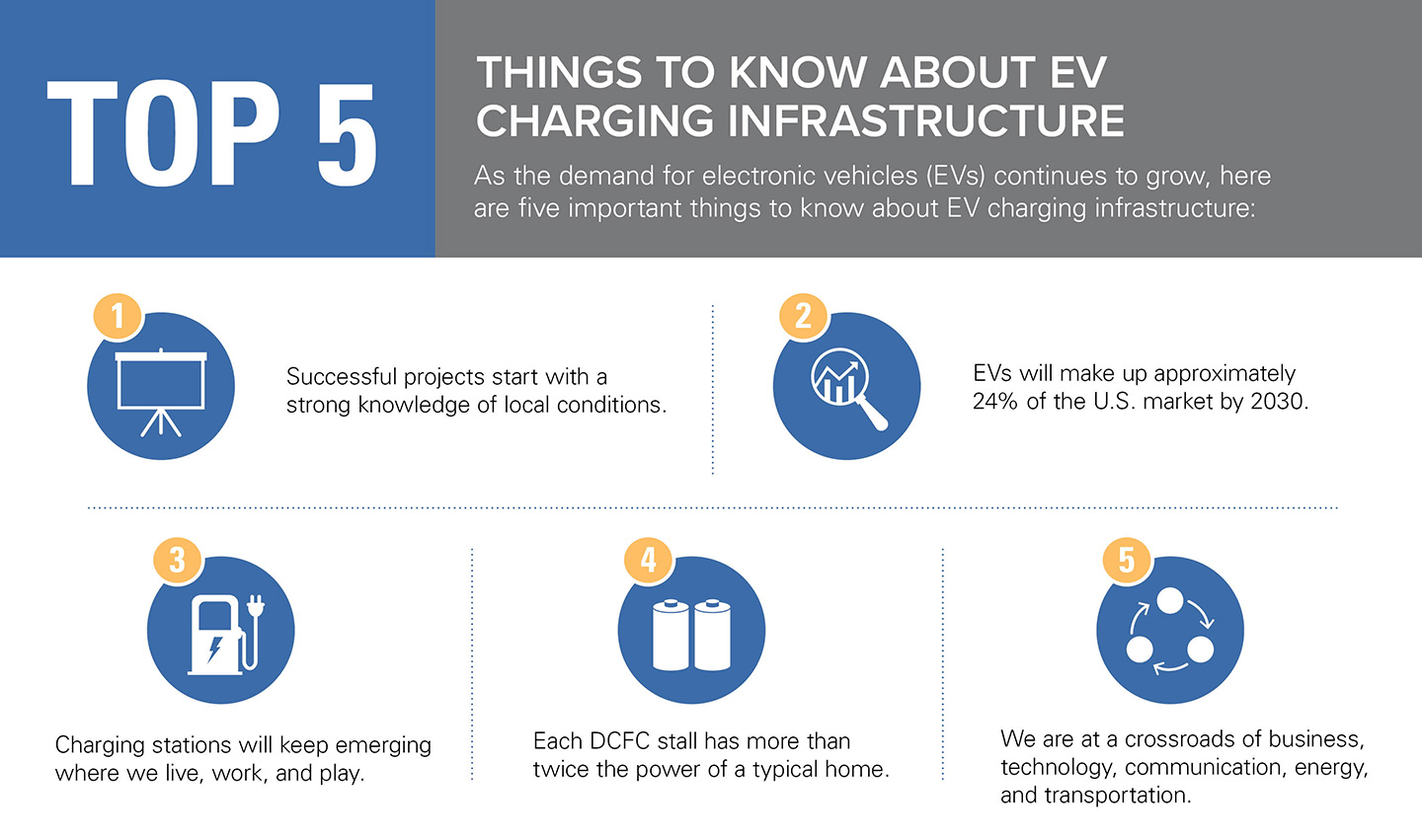As the demand for electronic vehicles (EVs) continues to grow, here are five important things to know about EV charging infrastructure:
- Successful projects start with a strong knowledge of local conditions.
A local engineering team can provide a strong working knowledge of a region’s physical, political, regulatory, economic, and demographic factors. In-person support and awareness of local zoning restrictions, plan development, review processes,
and codes and ordinances allow for a smooth permitting process. Familiarity with state legislation—and how laws apply to these projects—is also key, as well as understanding funding sources that can be critical to moving projects forward.
Early outreach to local power utility companies and knowing their design standards helps projects run smoothly during construction. Local engineering support also facilitates access to important site information, including data that may not be
available through the existing conditions survey. Permitting and utility coordination can often prove to be long lead items on EV projects. Engaging owners, jurisdictions, and utilities early and often is key to a successful project.
- EVs will make up approximately 24% of the U.S. market by 2030.
According to BloombergNEF, which researches the global energy and transportation market segments, passenger EV sales are predicted to reach 8.5 million units worldwide by 2025, or approximately
10% of all new car sales. By 2040, that figure is projected to reach as much as 54 million units, with EVs representing half of all passenger car sales. In the U.S., EVs will make up approximately 7% of the market by 2025 and 24% by 2030.
Key factors that will enhance vehicle pricing and popularity include the decreasing costs of batteries, improvements to the flexibility and reliability of the electric grid, and the growing availability of charging stations. Developing a network of
Direct-Current Fast Charging (DCFC) stalls along highways and alternative fuel corridors is crucial in the mass adoption of EVs. There are more than 47,000 EV (Level 2 and 3) charging stations across the country according to the U.S. Department
of Energy. Endorsed by President Biden, the goal is to go all electric in the next 10-15 years—requiring approximately three million public charging points.
Today’s charging infrastructure will have to increase by more than 15 times over the next 10 years."
Dave Revette
- Charging stations will keep emerging where we live, work, and play.
While most EV charging will continue to occur at home, many municipalities, businesses, and energy providers are now launching programs to install public charging stations near office buildings, shopping centers, civic buildings, multi-family housing
complexes, sports fields, and highway travel plazas, often with the support of government grants and a goal of meeting net-zero carbon goals.
EV chargers currently come in three different models: Level 1, Level 2, and Level 3. Level 1 is the simplest level of EV charging, taking 8-24 hours to charge a vehicle at home.
Places like offices, libraries, and sports fields are ideal for Level 2 chargers where people may be parking their vehicle for 2-3 hours or more. EV charger locations that integrate Americans’ daily activities will also increase adoption, such
as stations near coffee shops and other amenities. Level 2 provides a vehicle 25-30 miles per hour of charge.
Travel plazas and gas stations are better suited for Level 3/DCFC chargers. As the fastest charge, DCFC is ideal when traveling extended distances that require short recharge stops along the way. These chargers bring a vehicle near empty to about
80% in 20-30 minutes.

- Each DCFC stall has more than twice the power of a typical home.
The amount of power required for a DCFC station is significant. Each stall has more than twice the power of a typical home. For an eight-stall charging project, a utility would generally require a 750kva transformer and 1000A 480V power distribution
switchgear to power the AC/DC rectifier cabinets and the chargers themselves. Larger stations can require up to 2500 amps of high voltage power or more, whereas a home typically has 200 amps of lower voltage power. This power consumption can have
implications on grid reliability. Utility companies will need to collaborate so that the grid can handle the required load as stations continue to grow in number.
- We are at a crossroads of business, technology, communication, energy, and transportation.
As of September 2021, there were 2,147,070 EVs and 109,307 charger ports in the U.S. By 2030, 9.6 million charger ports will be needed, based on the Edison Electric Institute (EEI) forecast.
Researchers at Cornell University recently developed a new wireless charging system for EVs so they can be charged while on the highway. This approach, inspired by NASA’s system of sending data through deep space, could revolutionize EV charging
infrastructure by allowing EVs and autonomous vehicles to charge while driving.
We have designed more than 6,000 stalls and over 600 EV charging stations in 26 states at greenfield sites, existing parking lots, and parking garages, with services including due diligence, design, and construction. As more and more
EVs hit the road, the biggest challenge will be making sure there are enough charging stations. Forward-thinking clients, including state and local agencies, utilities, and car manufacturers, are installing charging stations that can be expanded
as demand rises.